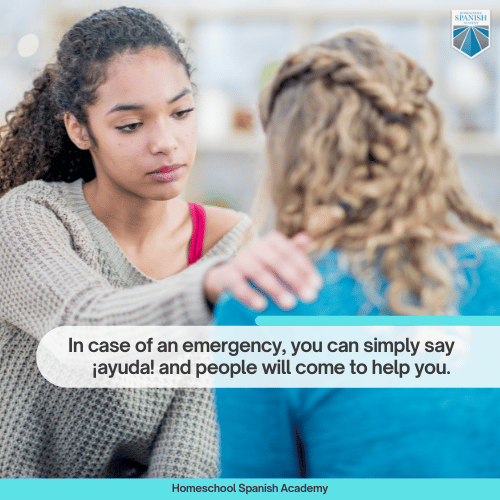Do you know how to ask for help in Spanish in case of an emergency?
Let’s not be dramatic, but how would you ask for help if you get lost in a secluded beach town in Mexico?
Learning how to ask for help in Spanish is a crucial topic when learning the language. However, there are different ways to do it, and not all apply to every situation.
To achieve fluency in Spanish, you must learn to recognize these situations and the correct vocabulary to use in each one.
Keep reading if you wish to understand the importance of knowing how to ask for help in Spanish and learn basic vocabulary and phrases to ask for help in Spanish.
You will learn about different scenarios and conversation examples and when you need to apply your newly acquired knowledge in the Spanish language.
Join 559 million people on the planet who speak Spanish!
Sign up for your free trial Spanish class today. 
The Importance of Knowing How to Ask for Help in Spanish
Knowing how to ask for help in your language is vital, as you never know when you might need it.
Well, asking for help in Spanish is the same, especially if you’re in a Spanish-speaking country or community.
Communicating is the primary function of any language. However, some ideas are more urgent to communicate than others, including asking for help.
Knowing how to order your drinks at a Mexican beach town is nice, but you must also know how to communicate your message to the locals in an emergency.
Take a look at 100+ Basic Spanish Words and Phrases for Travelers
Basic vocabulary and Phrases for Requesting Help
So, how do you say help in Spanish? Well, the Spanish word for help is ayuda, but as you may know by now, things aren’t as simple as that in Spanish. Let me explain.
In case of an emergency, you can simply say ¡ayuda! and people will come to help you.
However, in Spanish, help is also a verb that takes the form of ayudar. Let’s look at the present, simple past, and future tense conjugations of the verb help in Spanish.
|
Present
|
Ayudar
|
|
yo
|
ayudo
|
|
tú
|
ayudas
|
|
él/ella
|
ayuda
|
|
nosotros
|
ayudamos
|
|
ustedes
|
ayudan
|
|
ellos/ellas
|
ayudan
|
|
Simple Past
|
Ayudar
|
|
yo
|
ayudé
|
|
tú
|
ayudaste
|
|
él/ella
|
ayudó
|
|
nosotros
|
ayudamos
|
|
ustedes
|
ayudaron
|
|
ellos/ellas
|
ayudaron
|
|
Future
|
Ayudar
|
|
yo
|
ayudaré
|
|
tú
|
ayudarás
|
|
él/ella
|
ayudará
|
|
nosotros
|
ayudaremos
|
|
ustedes
|
ayudarán
|
|
ellos/ellas
|
ayudarán
|
Other words you can use to say help in Spanish are socorro, auxilio, and ayúdame or ayúdeme.
These last two terms translate as help me in Spanish, and their only difference is that ayúdame is informal while ayúdeme is formal.
However, during an emergency, the formality of the word isn’t that important.
Phrases and Questions to Ask for Help in Spanish
The following are some of the most common phrases and questions used to ask for help in Spanish:
Can you help me?
This simple question can be translated in multiple ways to Spanish. Let’s see the most usual ones.
¿Me ayudas? (informal)
¿Me ayuda? (formal)
¿Me puedes ayudar? (informal)
¿Me puede ayudar? (formal)
Could you help me?
Similar to the previous question, just change “can” to “could” to make it slightly more polite.
¿Podrías ayudarme? (informal)
¿Podría ayudarme? (formal)
Add por favor at the end of these six questions, and you’ll have the same as “Can you help me please?” and “Could you help me please?”
Would you mind helping me?
A not-so-direct variant signals that your need for help isn’t that urgent or desperate.
¿Te importaría ayudarme? (informal)
¿Le importaría ayudarme? (formal)
Can somebody help me?
This question is usually asked after a couple of initial but unanswered tries for help.
¿Puede alguien ayudarme?
I need help
A straightforward request for help.
Necesito ayuda
Could you give me a hand?
The first time we don’t include the word “help” in this lesson.
The same thing happens in Spanish. The word ayuda is replaced by the idiom of dar una mano, which means the same as in English: to lend a hand or to help someone.
¿Me podrías dar una mano?
¿Me das una mano?
Different Scenarios Where Asking for Help May Be Necessary
Let’s go through different scenarios where asking for help or even offering to help in Spanish may be necessary.
In a Shop
Imagine that you’re buying clothes at a shop in Argentina and need help from the shop assistant.
How would you ask for help? Which option of those seen above would apply in this case?
Miss, can you help me, please?
Señorita, ¿podría ayudarme, por favor?
In a Government Office
Let’s say you’re doing some tedious but urgent paperwork at a government office, and you’re lost.
They asked you to provide a specific document, but you don’t know where is the office you’re supposed to get it. What do you do?
How do you ask for help in Spanish in this case? Well, you just approach the nearest person that looks like they work there and ask directly.
Excuse me, I need help.
Disculpe, necesito ayuda.
In an Emergency
This might be the most dramatic scenario.
You just had a terrible car crash, and you need help to take your friend out of the car. A few bystanders are looking at you and the scene, but no one’s helping.
How do you ask them to help you in Spanish?
Help me to take him out of the car!
¡Ayúdenme a sacarlo del carro!
You Got Lost
In this scenario, you got lost in the woods or perhaps fell off a cliff and broke a leg, and there’s nobody around to be seen.
Which is the way to ask for help in this situation?
Help!
¡Socorro! (you could also shout ¡Auxilio! to the same effect)
Cultural Considerations and Polite Language
As you continue developing your Spanish language skills, you’ll become more accustomed to the formal (tú, vosotros) and informal (usted, ustedes) versions of the 2nd person in Spanish.
Actually, in the vocabulary studied above, when you read “formal” and “informal,” it was nothing else but to let you know which of the 2nd person conjugations we were using at the time.
However, a few cultural considerations are important to note when talking about how to ask for help in Spanish.
For starters, the language in Spain is much more informal than in Latin America.
Spanish people rarely use the usted or ustedes and often avoid the por favor and gracias. In a nutshell, they cut to the chase and go straight to the point.
On the other hand, Latin American people use a language still imbued with past centuries’ formality.
Colombia, for instance, rarely uses the tú as a conjugation, while no Latin American person ever uses the vosotros conjugation.
Practical Examples and Dialogues in Spanish
In this conversation practice, we’ll take you through a few examples of how to ask for help and how the conversation may develop.
Dialogue #1 – In a Shop
A – Hi, can you help me, please?
B – Yeah, sure. What do you need?
A – I’m looking for this medium-sized T-shirt, but I can’t find any.
B – Let me take a look.
A – Thank you very much.
—
A – Hola, ¿me puede ayudar por favor?
B – Sí claro, ¿qué necesita?
A – Estoy buscando esta camiseta en tamaño mediano, pero no encuentro ninguna.
B – Déjeme ver.
A- Muchas gracias.
Dialogue #2 – A Flat Tire
A – What happened?
B – I’ve got a flat tire. Could you give me a hand?
A – Sure.
B – Thank you!
—
A – ¿Qué pasó?
B – Se me ponchó una llanta. ¿Podrías darme una mano?
A – Por supuesto.
B – ¡Gracias!
Dialogue #3 – In a Car Crash
A – Help! Can somebody help me?
B – Yes, we’re here. What do you need?
A – I can’t unlock my seatbelt. Can you help me with that?
B – Sure, done!
A – Thank you very much!
—
A – ¡Auxilio! ¿Puede alguien ayudarme?
B – Sí, aquí estamos. ¿Qué necesitas?
A – No puedo desconectar mi cinturón de seguridad, ¿me puedes ayudar con eso?
B – Seguro, ¡listo!
A – ¡Muchas gracias!
When Asking for Help in Spanish, Practice Makes Perfect
Like most things in life, mastering how to ask for help in Spanish requires a lot of practice.
Because you may learn the needed vocabulary or the proper phrases, but languages are complex creatures, and practicing it is the only way to learn its hidden intricacies.
Only then you can feel the need for an extra por favor or gracias, or in which situation might be better to use the correct phrase.
These 50 Simple Spanish Questions to Ask in a Conversation can help you to keep practicing at home.
Another option would be to sign up today for a free trial class with one of our certified, native Spanish-speaking teachers from Guatemala and start speaking Spanish from your first class.
No payments or credit cards are required. We offer flexible scheduling and student-tailored Spanish programs.
Join one of the 40,000 classes that we teach each month and you can experience results like these
“This is the best way for your kid to learn Spanish. It’s one-on-one, taught by native Spanish speakers, and uses a curriculum.”
– Sharon K, Parent of 3
“It’s a great way to learn Spanish, from native Spanish speakers in a 1-on-1 environment. It’s been fairly easy to schedule classes around my daughter’s other classes. The best value for us has been ordering multiple classes at a time. All the instructors have been great!”
– Cindy D, Parent of 3
“HSA offers very affordable, quality, one on one classes with a native speaker. My son has greatly benefited from taking classes. We have seen his confidence increase as well as his pronunciation improve because he learns from a native Spanish speaker. HSA has quick, personal customer service. Our family has been very pleased with our experience so far!”
– Erica P. Parent of 1
Want more Spanish resources? Check these out!
The post How to ask for help in Spanish: A Conversation Guide appeared first on Homeschool Spanish Academy.

















